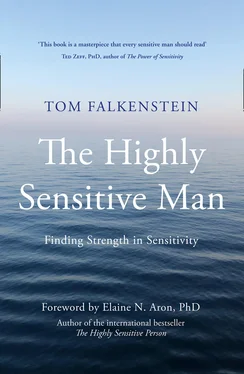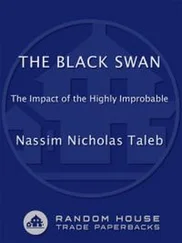Given all of this, I have been happy to help him in any way I could with this book. We had several video calls, Berlin to San Francisco. He asked good questions, and I think we enjoyed ourselves, too. Working with him, I found I trusted him, and I wish you could meet him, too. But I am sure his author’s voice will come across to you as warm, authentic, knowledgeable, and experienced—highly sensitive, perhaps like you.
— Elaine Aron
San Francisco
Introduction
“I HATE THAT I’M SO sensitive!” My client, a man in his mid twenties, was sitting across from me and had just clearly expressed how and why he felt so angry. It was the first warm day in London that spring, and suddenly the room was completely still. This young man had been coming to the clinic for some time and was being treated for recurrent depression. I was his psychotherapist, and over the course of his treatment, we kept indirectly coming back to the topic of sensitivity. But this was the first time that he had openly identified himself as sensitive and the first time that he had revealed the self-hatred he felt about his sensitivity. It was, for him, a painful but important step in dealing with his sensitive temperament, which he had struggled with since he was a child. For me, it was a key moment in my professional career because this client had clearly identified something that I had encountered countless times over the years in my work without, until that moment, having had a name for it or being able to concretely identify the phenomenon—the highly sensitive man.
During my postgraduate training in psychotherapy in Berlin, I kept coming across a particular type of client that I experienced as particularly sensitive, thoughtful, intuitive, conscientious, often introverted, and sometimes shy. These clients came to therapy for the most varied reasons: depression, anxiety, relationship problems. But they all shared an underlying characteristic: they were very sensitive, and because of this, they experienced their internal and external worlds in a very subtle and perceptive way.
After a while, I realized that I particularly enjoyed working with this group of clients, precisely because of the way that they perceived and dealt with the world. But it also became increasingly clear to me that it was my male, rather than my female clients who had the greatest problems with the sensitivity that they described and who in therapy often expressed a desire to be less sensitive. Again and again, I saw the huge amount of psychological suffering caused by the discrepancy between how these men were and how they thought a man should be. They often felt shame and a sense of inferiority about their sensitive disposition, which had been part of their lives since childhood, and they saw their sensitivity as “unmanly,” “feminine,” and “unattractive.” Many had tried for a long time to deny their sensitivity or to hide it from others—nearly always in vain. The conviction that being sensitive meant that you couldn’t be manly seemed deeply rooted.
During my sessions, I constantly heard male clients saying that they wished they were tougher, more physically and mentally resilient, and that they wished they could learn to be more extroverted in social situations. They usually thought that it was this that would make them more successful in their jobs and more attractive to potential partners. Often these men also wanted to have less-conflicted relationships with their own fathers and with other men. Essentially, though, it always came back to the same basic idea: they wanted to be more like what they saw as a “typical man.” And this typical man was not particularly sensitive.
At that time, I hadn’t yet come across the concept of high sensitivity as an innate temperamental trait (i.e., a characteristic that you are born with) and wasn’t aware of the extensive research done regarding the highly sensitive person (HSP) by the clinical psychologist Elaine Aron, Ph.D., and her colleagues. She has been researching this concept since the early 1990s, when she began to look into the concept of “innate sensitivity” in certain people. It was a concept that Carl Jung, the Swiss psychiatrist and founder of analytical psychology, had described as early as 1913. With my interest piqued by my experiences in London, I began to read more and more about human sensitivity and discovered the concept of sensory processing sensitivity, as high sensitivity is called in academic research. I had the feeling that I had come across a groundbreaking psychological concept that was going to have a huge impact on my work as a therapist. The idea that people are born with different sensitivities that affect the way that they react to the world around them seemed to explain so many things I had seen in my practice. So over the next few years, I immersed myself in all of the available material on high sensitivity and began a dialogue with Elaine Aron, who gave me an in-depth personal insight into her research and her therapeutic work with highly sensitive patients.
As I began to investigate the subject of high sensitivity more deeply, I really struggled to find books that described the specific challenges of high sensitivity from a male perspective. The majority of books on high sensitivity were written by women and seemed to be primarily aimed at female readers. Yet in my psychotherapeutic practice and my consultancy work, I saw that it was particularly men who struggled with being highly sensitive. And although a few self-help books touch on the difficulties that sensitive men experience when trying to live up to traditional ideas about masculinity in Western culture, there is still no book that really focuses on the topic of highly sensitive masculinity, which, of course, only exacerbates the taboo around it. That’s what I want to change with this book.
It is important to me that this book contributes to the long-neglected issue of empowerment for highly sensitive men because I believe that their role in the world is very important and that it comes with many challenges and opportunities. I consider the high sensitivity of many men to be a completely essential part of masculine identity and something that can enrich the lives of these men and the lives of others. Sensitivity is in no way a shameful or “unmanly” flaw that one has to get over.
To see the opportunities that your sensitivity offers you, however, you have to learn to deal well and responsibly with it. You have to accept it, learn to value it, and use it positively in your relationships with other people. When this happens, I believe that a highly sensitive disposition can make men particularly good fathers, husbands, partners, son, brothers, and friends.
At the same time, I think it’s important to say that your high sensitivity—once you’ve detected it and identified it—should not be used as an excuse to avoid doing things that you actually just don’t want to do. I also believe that it is not something to become arrogant or boastful about, in the sense of “I’m special, because I’m so sensitive.” High sensitivity is a completely neutral disposition, an innate temperamental trait. 1Having a highly sensitive disposition is not automatically a good thing nor is it a bad thing. It is, of course, an important part of your personality, but at the end of the day it is exactly that—one part, one aspect of your complex personal makeup. I thus feel that it’s problematic to reduce yourself to that one quality or to wear your highly sensitive nature like a badge of honor. I see highly sensitive men as neither “delicate flowers” nor as “golden children.”
In my work with highly sensitive clients, I often compare a highly sensitive disposition to being born with very fair skin. You can complain that you weren’t born with darker skin, and you might be envious of friends who are able to sun themselves on the beach, in the garden, or in the park and not worry about burning. But at the end of the day, you have to accept that your skin is different. It’s not better, not worse, just different. People with very fair skin can also go sunbathing if they want; they just can’t stay in the sun for as long as other people. They also have to take different precautions, such as using high SPF sunscreen, finding somewhere shady to sit, and wearing a hat or light-colored clothing. In fact, people with pale skin can enjoy the “sunny” moments in life just as much as anyone else; they just have to learn how to do it in their own and sometimes a slightly different way. And that’s the crux of the matter: to accept the situation as it actually is and, ultimately, to find your own individual and authentic way of learning to live with it.
Читать дальше












